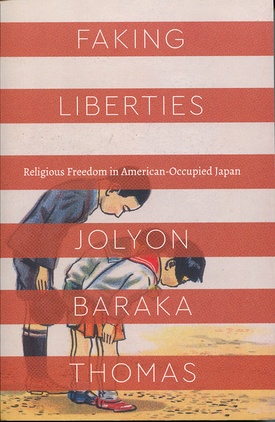Although only an assistant professor of religious studies at the University of Pennsylvania, Jolyon Baraka Thomas has already published one remarkable book, Drawing on Tradition: Manga, Anime, and Religion in Contemporary Japan (University of Hawai‘i Press), and is presently working on a third book with the tentative title of “Difficult Subjects: Debating Religion and Public Education in Japan and the United States.” As for the volume under review here, Thomas’ second book, it is a brilliantly conceived, deeply researched, tightly argued, and elegantly composed comparative and transnational inquiry into the concept and practice of religious freedom, with particular emphasis upon Japan’s Meiji era and its post-World War II Allied (mainly U.S.) Occupation period.
Because the content and character of Faking Liberties defies my powers as a non-specialist to summarize in a short review, perhaps at this juncture the wisest path for me to pursue to stimulate your interest in and facilitate comprehension of Thomas’ book is to permit the author to provide you with a summary in his own well-chosen words.
Having heard from Thomas about his book, I would next recommend that you read his very personal and probing seven-page epilogue, “Songs of Freedom,” before tackling the book per se. When you do, you will be exposed to his family background (his white mother was reared in a small town in Iowa as the offspring of parents with religious ties, a cosmopolitan outlook, a regard for civil rights, and a proclivity for social justice, while his black father was brought up in South Side of Chicago and then educated in rural Iowa at the small liberal arts college of Grinnell, where he met his future wife and, additionally, was placed on an FBI watch list for his activities as co-founder of the Concerned Black Students campus organization — which left him cynical about the U.S. promise of freedom and afterward led him to teach Jolyon and his brother “to be suspicious of authority and keenly aware of the double standard that all black men face in America” (pp. 262).
You will also be informed about Thomas’ coming of age in the 1980s in the overwhelmingly white city of Des Moines, during which time he absorbed the lesson that some people were more free than others (punctuated at age 17 during a stopped car incident by a cop threatening to kill him while treating his accompanying two wealthy white friends deferentially) — which prompted him to move to Japan after the Sept. 11 terrorist attacks, where he stayed for two stints (2002-4 and 2005-7) and experienced racial profiling both from Tokyo police officers and, on trips back to the U.S., by American airport officials.
Furthermore, reading Thomas’ epilogue will alert you to how, during research in Japan in 2013 for Faking Liberties, he was harassed at Tokyo nightclubs by police patrols cracking down on “unseemly fraternization between local Japanese people and American service members” (pp. 263-4), a legacy from the 1945-52 Allied Occupation. It will also inform you that when Thomas was writing his book in the U.S. at a time when the police murder of black people was on a steep upsurge and the Black Lives Matter movement was rising in response, he agonized internally as to how his “academic inquiry into the politics of religious freedom could fit with the ongoing project of perfecting liberty in America” (pp. 264).
For many years, I taught a graduate seminar in history at California State University, Fullerton, titled “History and Historians.” What this course emphasized was that the historical writings of historians were powerfully shaped by their sociocultural experiences. In the case of Thomas, his “long-standing curiosity about rights, freedom, and America’s protean definitions of personhood dovetailed with … (his) enduring professional fascination with the conundrum of how the categories of ‘religion’ and ‘not-religion’ have operated and continue to operate in modern Japan and elsewhere” (pp. 266).
FAKING LIBERTIES: RELIGIOUS FREEDOM IN AMERICAN-OCCUPIED JAPAN
By Jolyon Baraka Thomas
(Chicago: University of Chicago Press, 2019, 336 pp., $32.50, paperback)
*This article was originally published on Nichi Bei Weekly on July 18, 2019.
© 2019 Arthur A. Hansen / Nichi Bei Weekly








